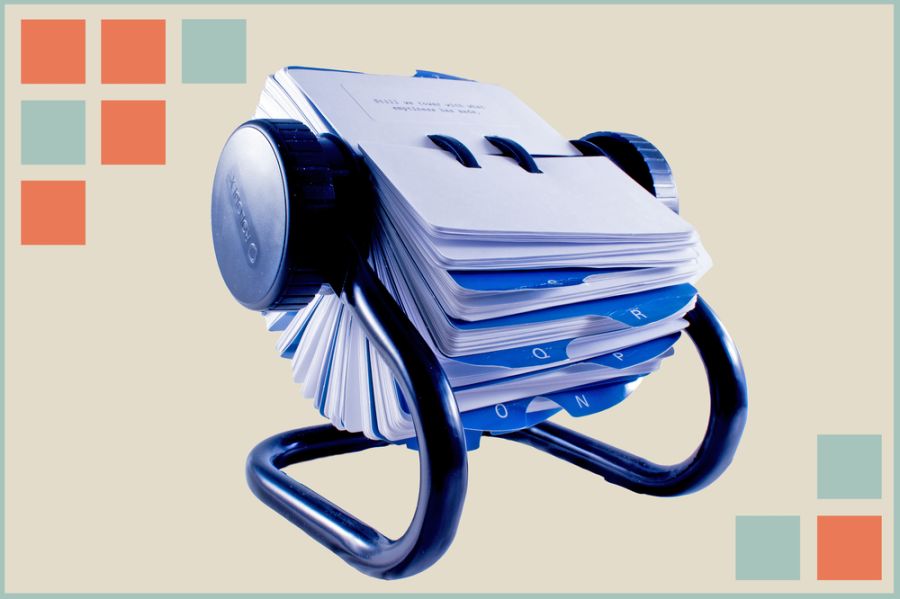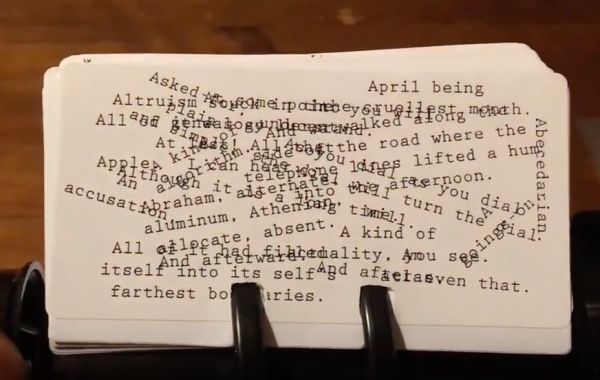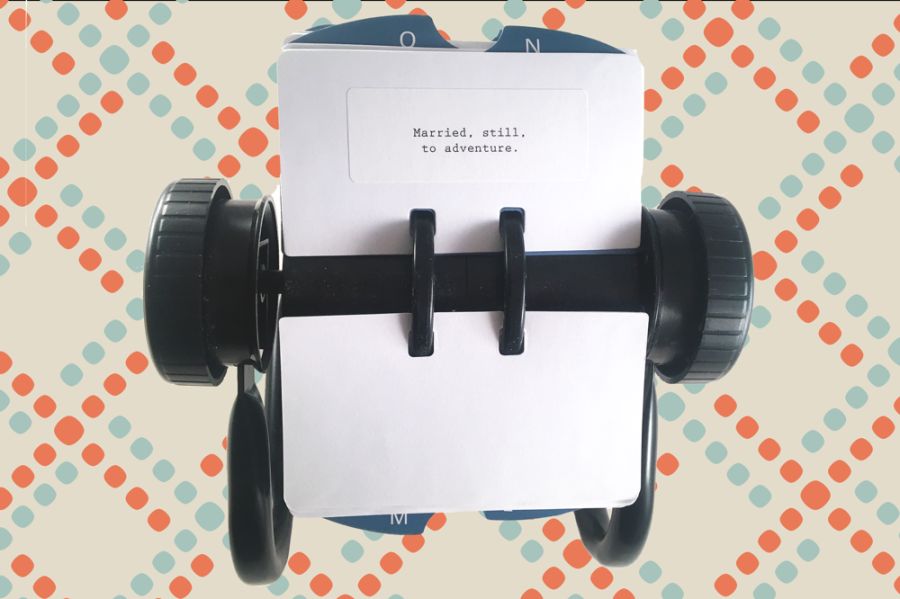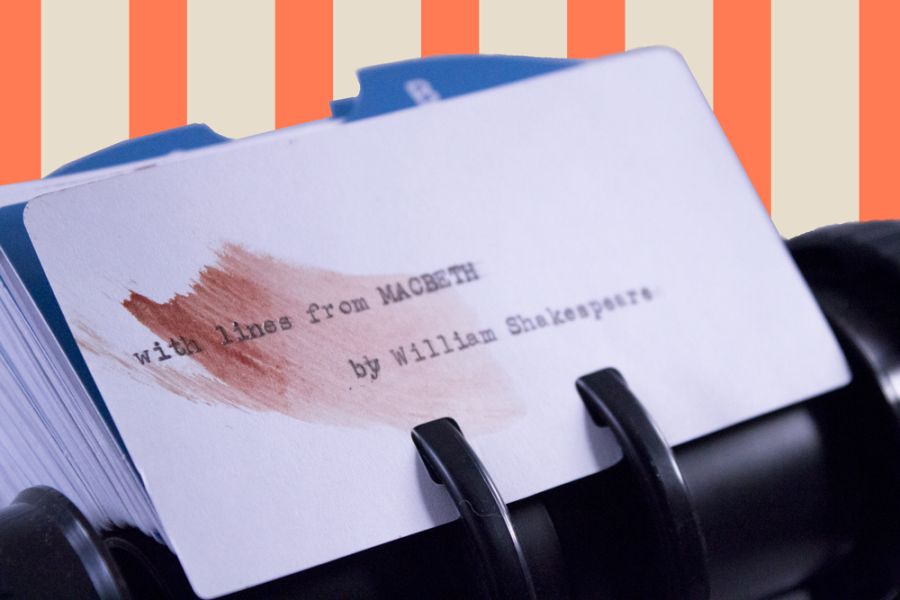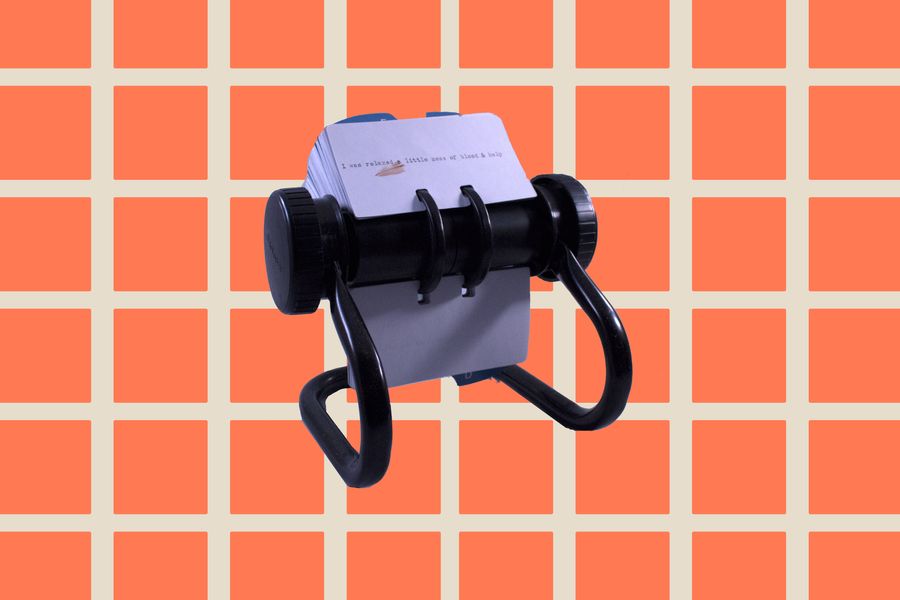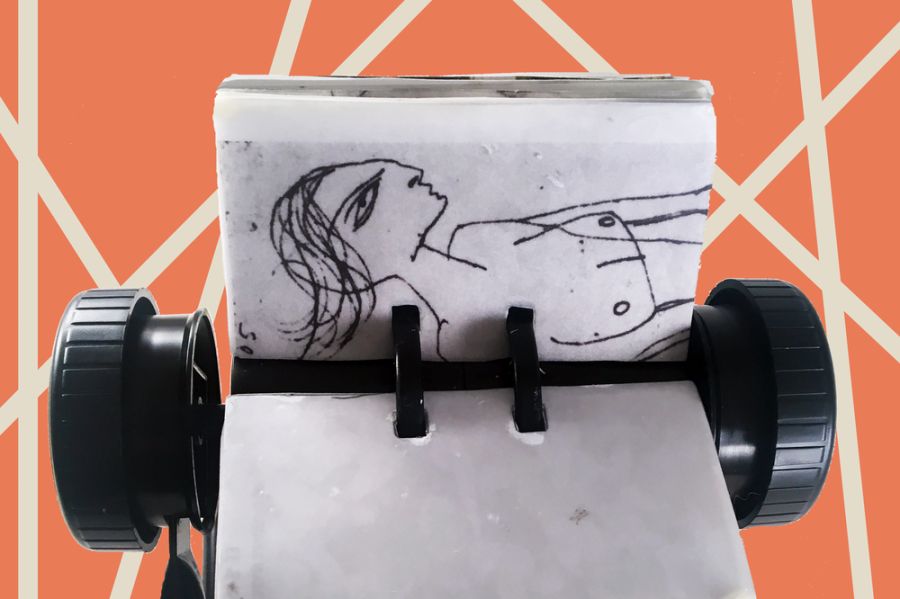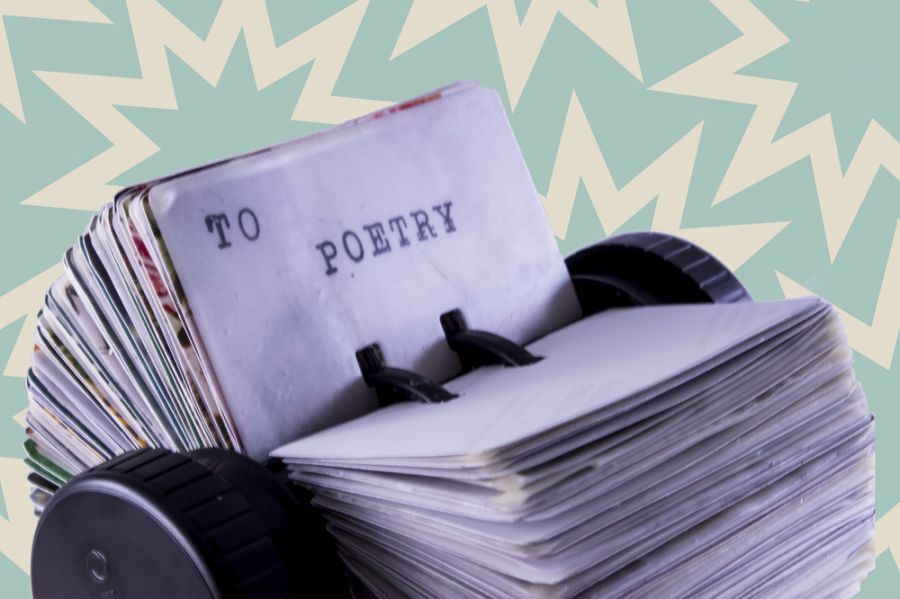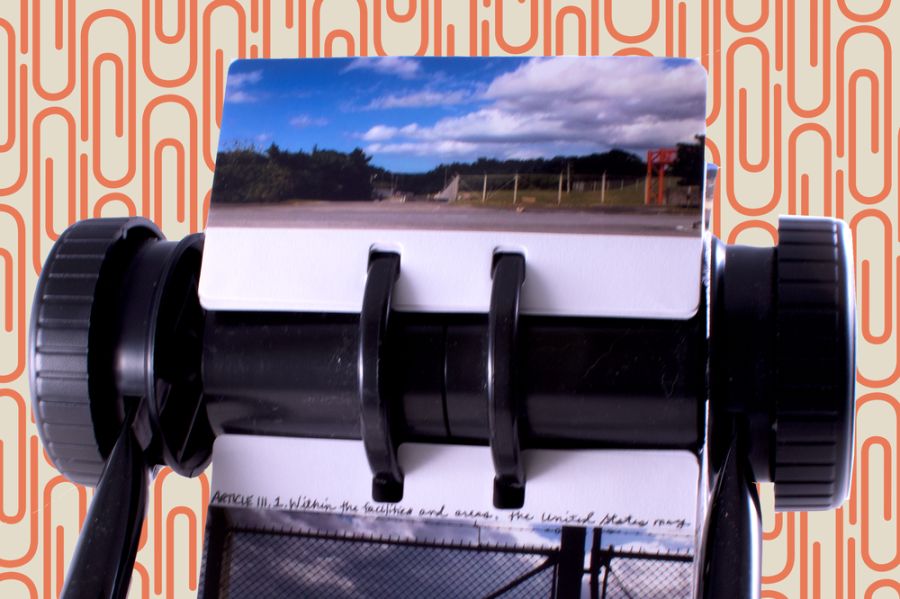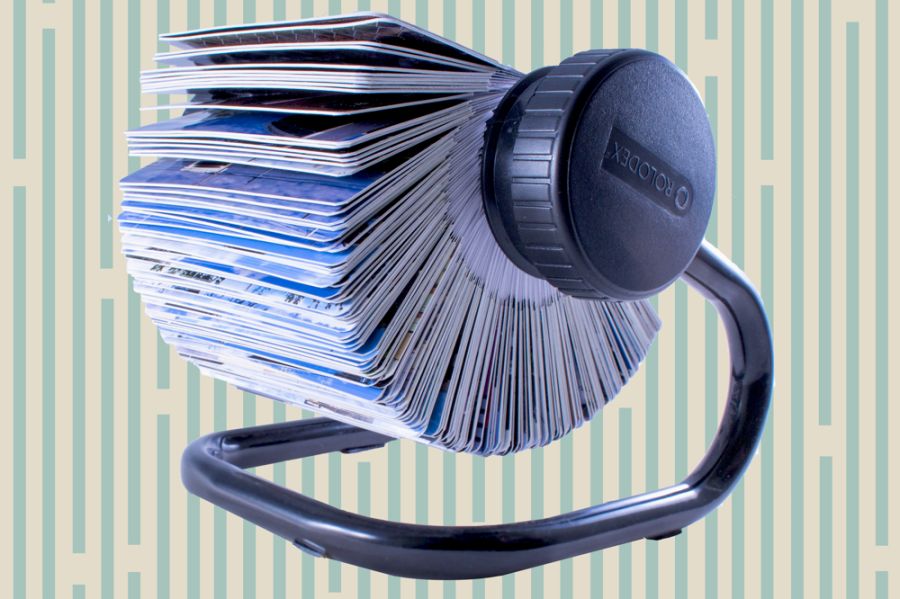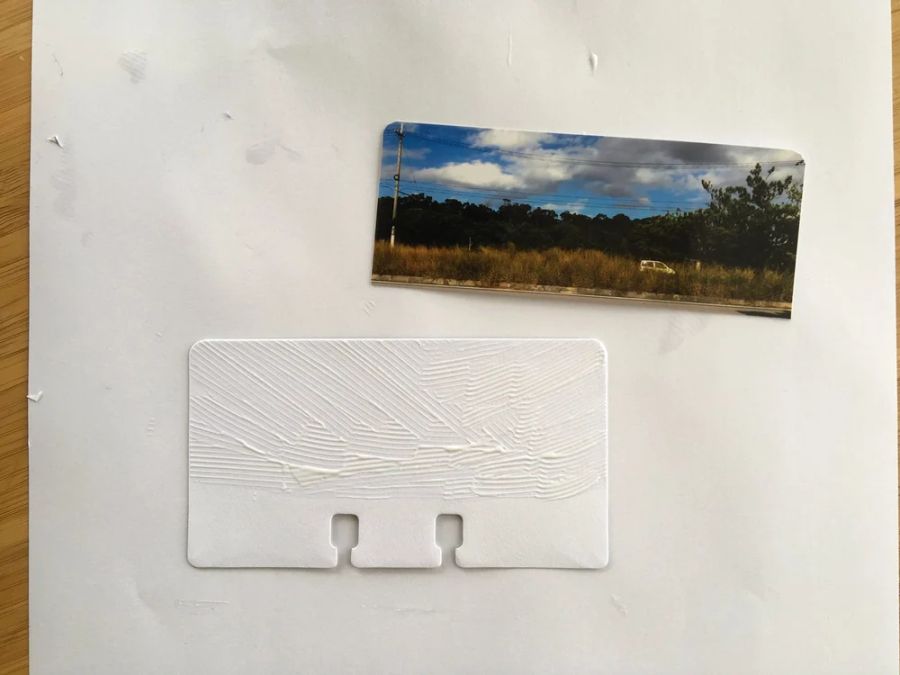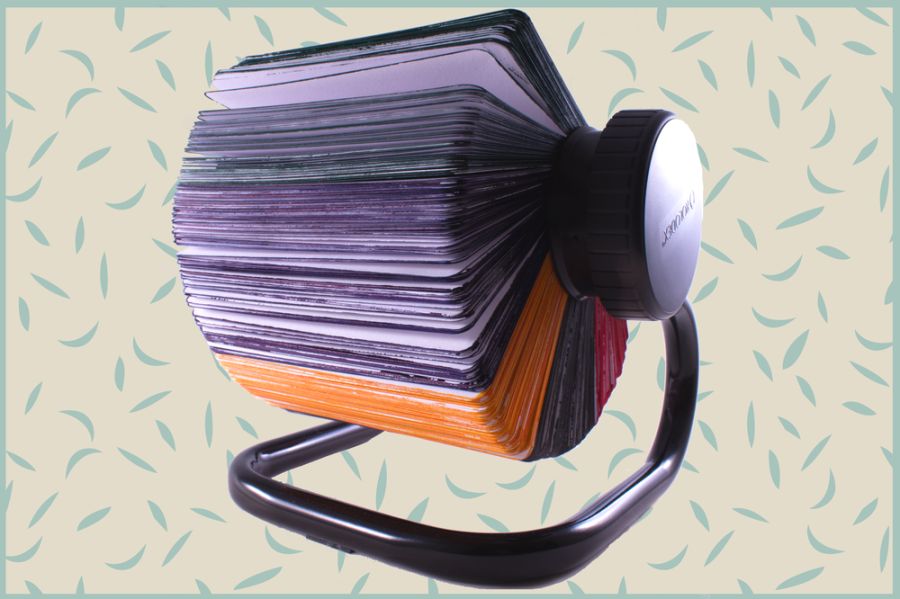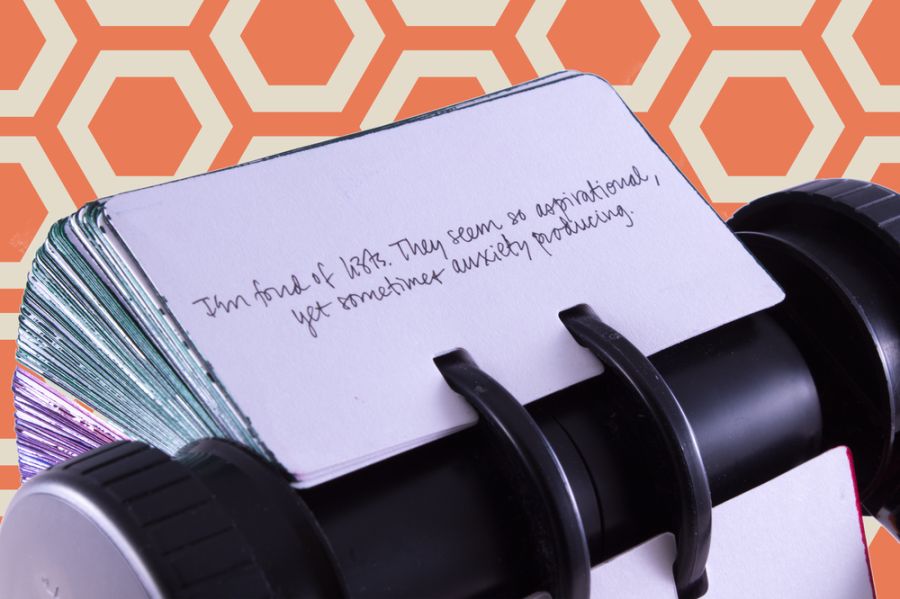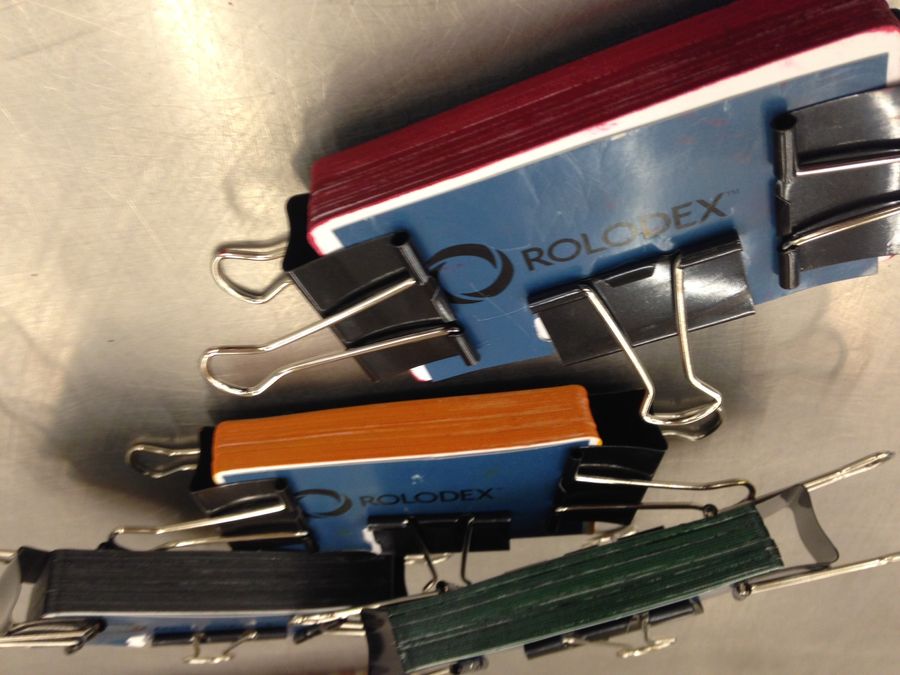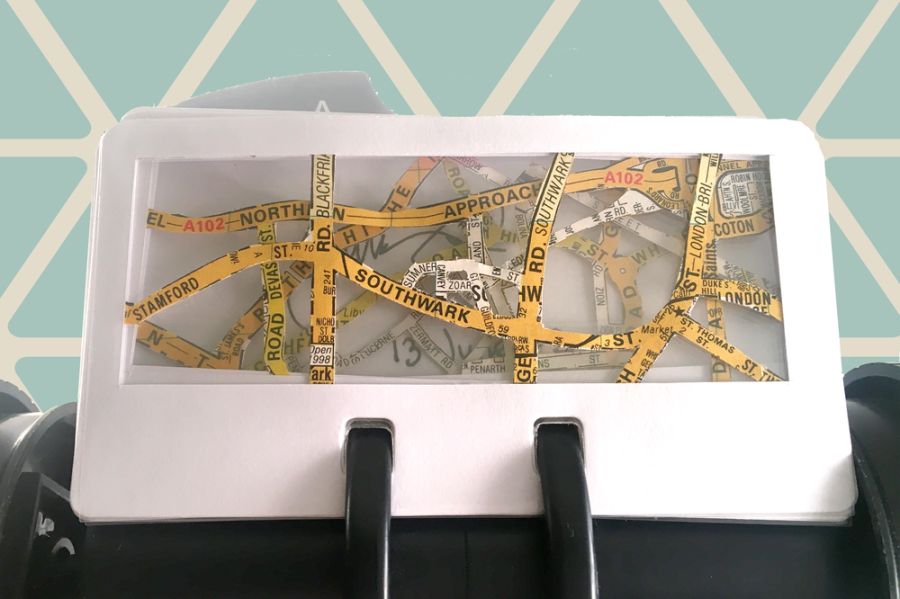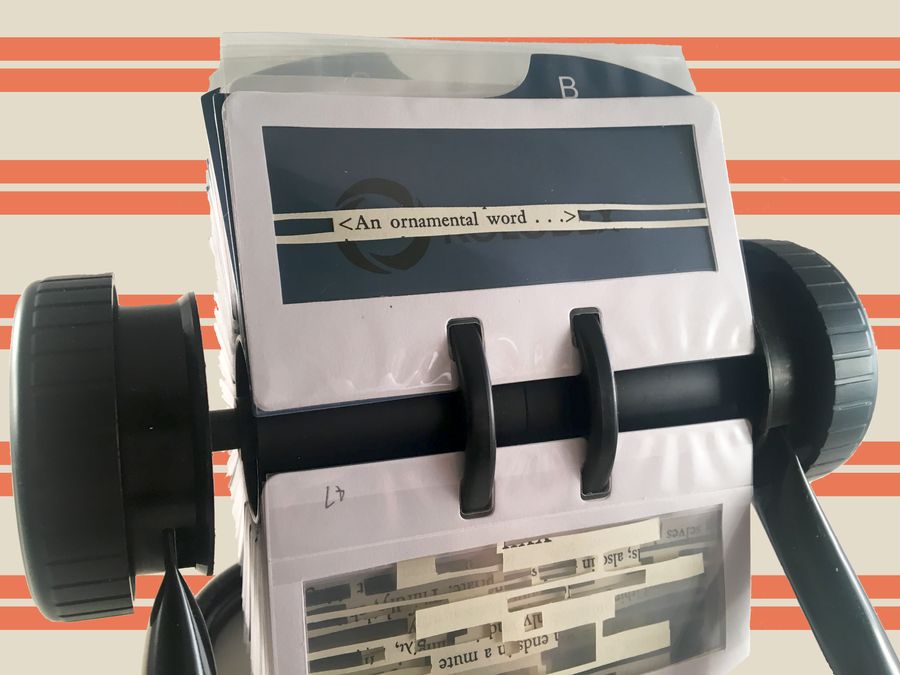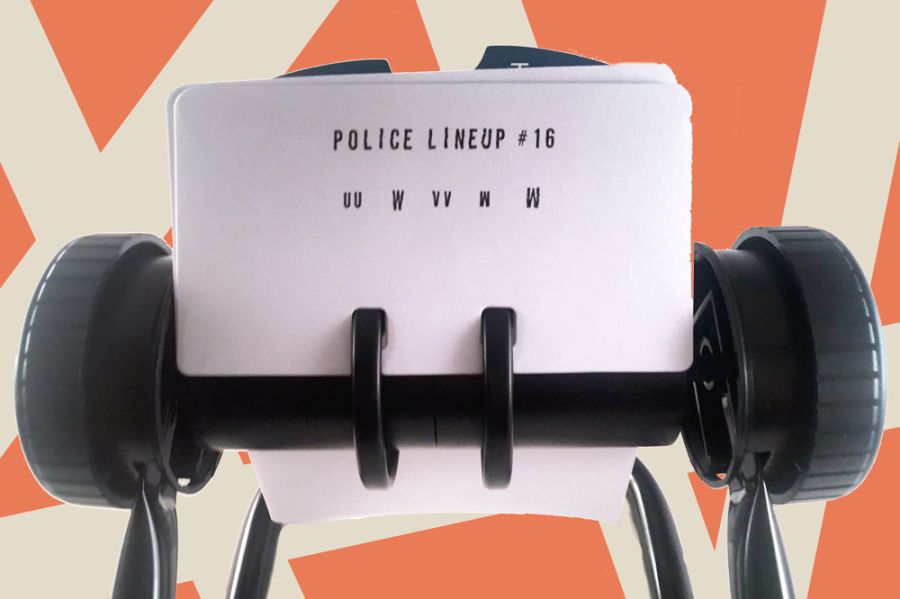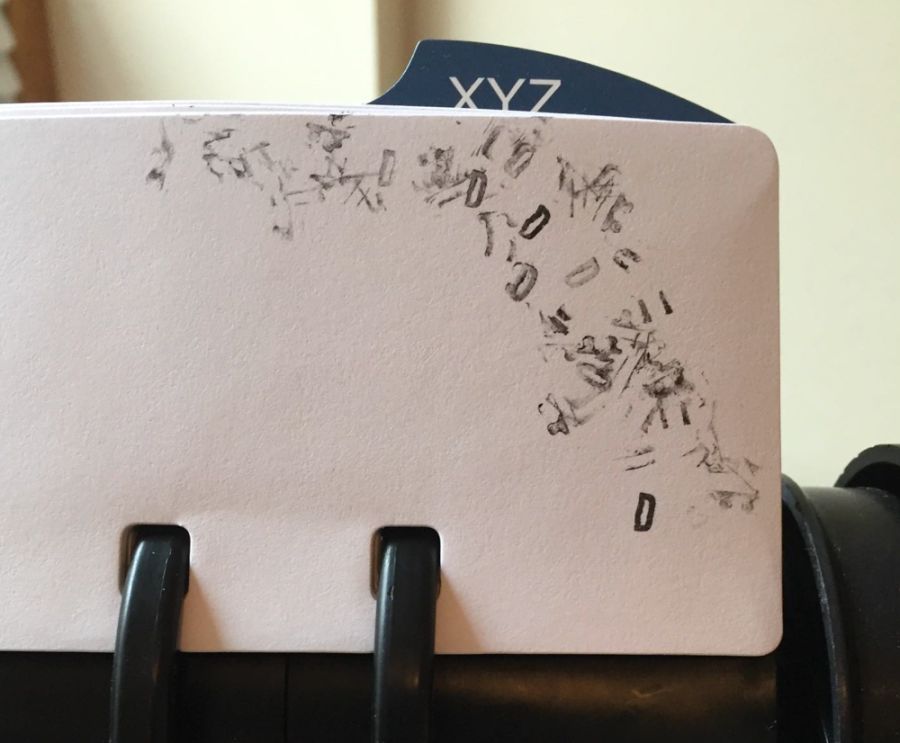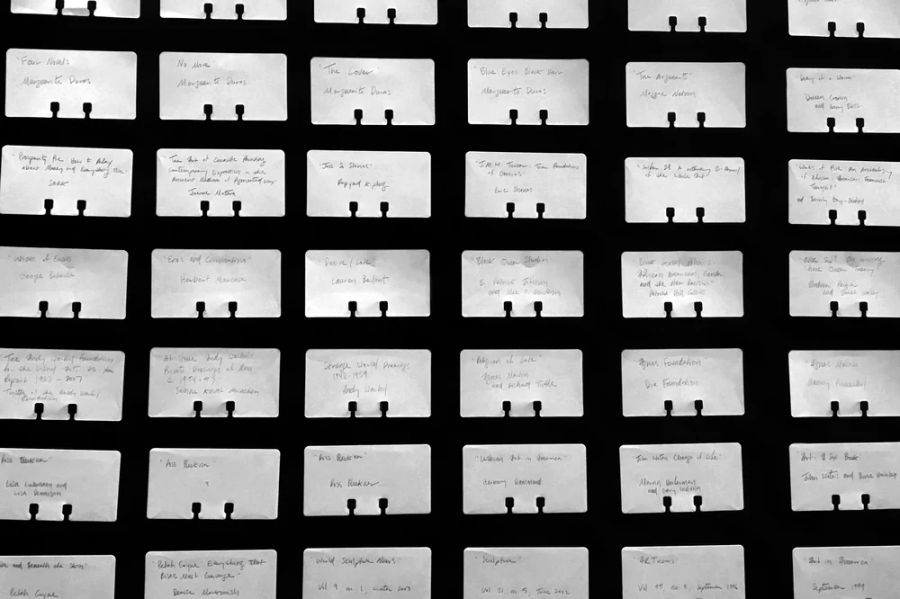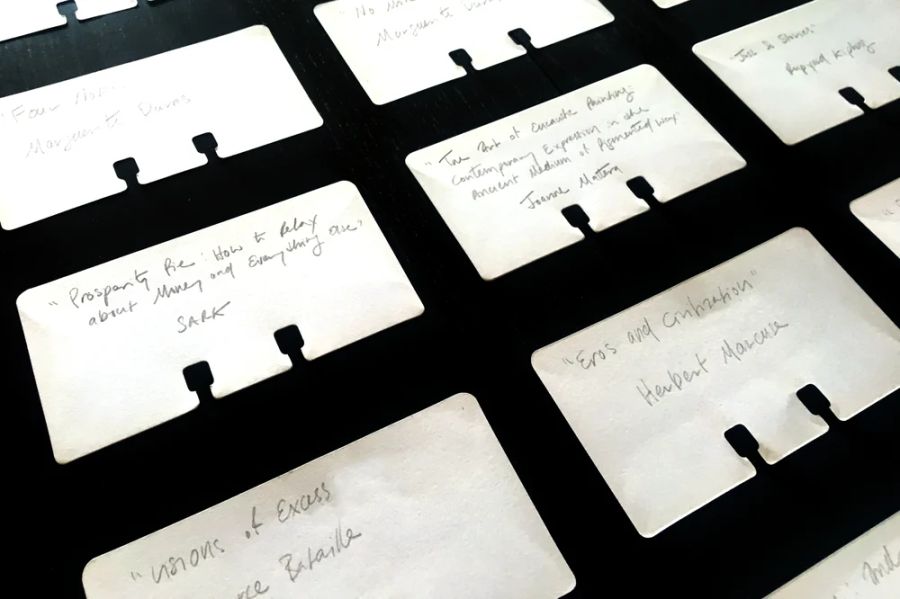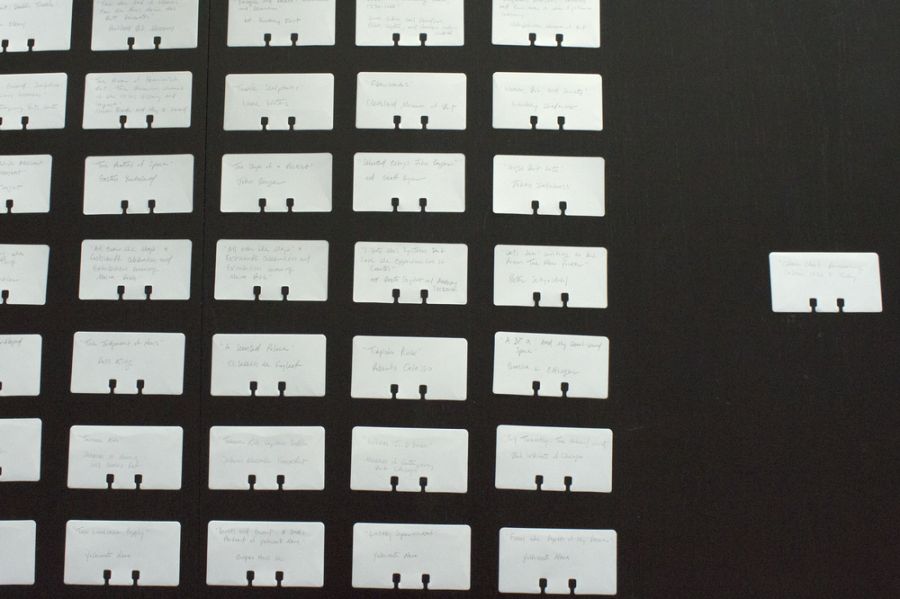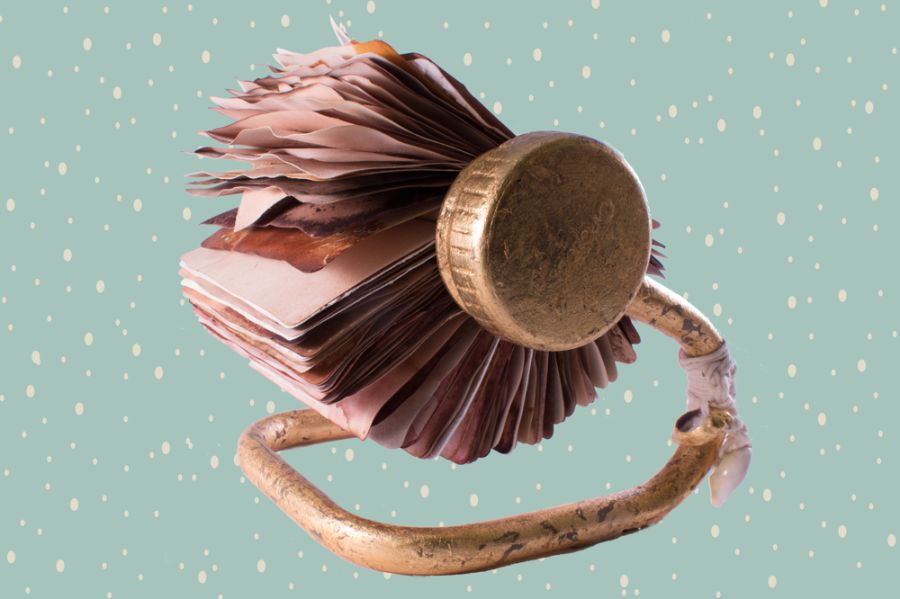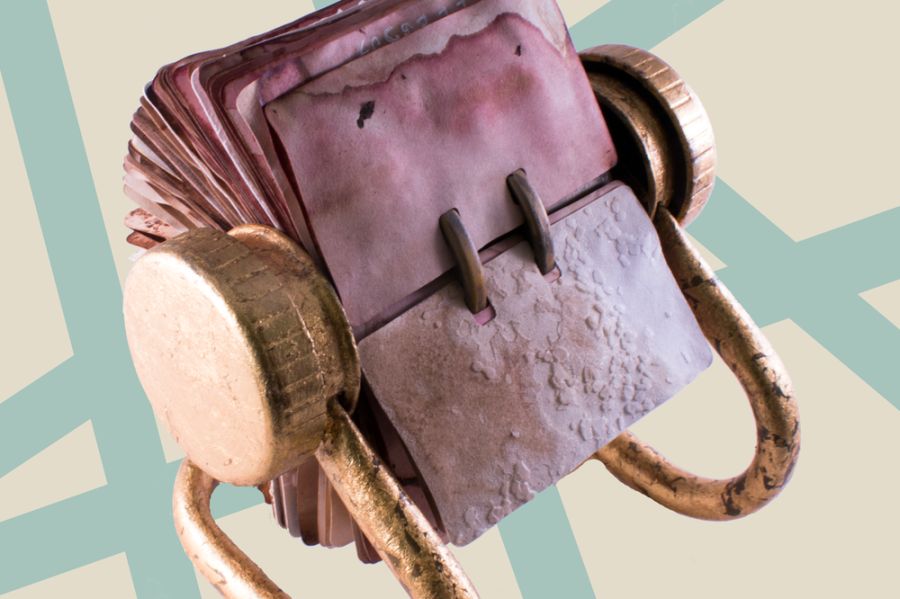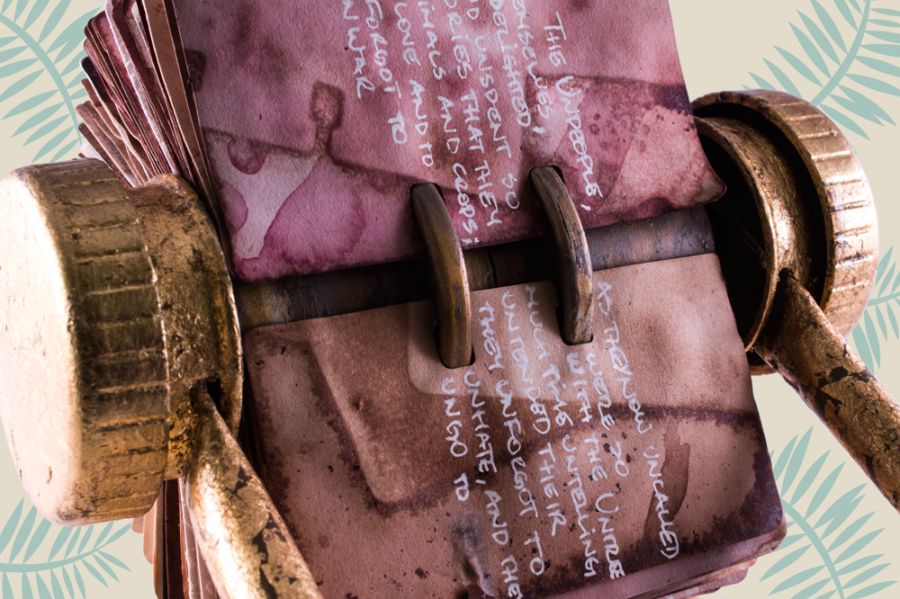Alphabet: A Rolodex Poem
I always ask myself how an art work explores the limitations of its own medium (this is something of an internalization of Clement Greenberg), so I tried very hard not to subvert the form the rolodex was already providing. It is, essentially, an address book, so I knew right away that I wanted the poem to have a quality of direct address, or otherwise a feeling of telephonic intimacy. This initiated the voice, which I knew would have to adapt over the course of the project to the other prevailing formal characteristic: the rolodex's alphabetical organization.
This second formal quality organizes the poem globally. Each lettered sections contains phrases that begin with and also generally emphasize that letter. This opened up possibilities for all kinds of themes and nexuses between them. For instance, section "L" focuses on love. Section "S" is a sonnet. Section's "I" and "T" function as corresponding if/then statements, and so on. As various prevalences arose, I let the voice shift into their character. Finally, I had to figure out what to do with the combined "X, Y, Z" section. Jumping from the idea that these letters were "smashed together," I decided it could function as in an index (as you can see in the video), with every entry for each letter run superimposed on a single card.
When the rolodex first arrived unadorned in the mail, I spent weeks just holding it in my hand trying to understand it as both a material and social object. Initially I wanted to mar it: paint it, cut it up, etch it, glue it, string it with lights, or produce any number of other materially oriented marks, but the more I sat with it the more I realized what an everyday and strictly functional object it was, relatively cheaply produced and residing firmly in the category of ephemeral office products (alongside binders, manilla folders, reams of paper, packing tape, cheap pens, and so on).
I remembered the Greenberg thing. I looked up how people use the rolodex, and many simply print off mailing labels with contact information. So the only other material I've used is generic mailing labels and the attendant InDesign templates. As such, it was important to me that I also write the poem directly within the template, which became an interesting and different space in which to work--especially as a book publisher who watches manuscripts go through the "process" of design. This project enabled me to bridge composition and design, and while in practice that was done in the intangible space of design software, I found it still lent a more material aspect to the composition process, which was exciting.
About the artist
Ryo Yamaguchi

Ryo Yamaguchi is the author of The Refusal of Suitors (Noemi Press). His poems have appeared in outlets such as Denver Quarterly, The Iowa Review, and Gulf Coast, among others, and his book reviews and other critical writings can be found regularly at places such as Michigan Quarterly Review and Newpages. He lives in Seattle where he works at Wave Books. Please visit him at plotsandoaths.com.
blood & ink on paper
People are viscerally afraid of blood: just the sight of it can cause some to literally lose consciousness. While part of this makes sense to me (we generally prefer to keep the insides of our bodies, well, inside our bodies), seeing blood has always filled me with both wonder & gratitude. My blood is proof that I am alive, proof that I am still able to be wounded, proof of my beautiful & sacred fragility.
When writing, I often feel as if the poem is a physical part of me: a small piece of my self that I am extracting & sending into the world. I decided to take the metaphor one step further & enact it on the cards of the Rolodex, smearing small amounts of my own blood, gleaned by the pricking of my thumbs, onto each one.
This poem, a series of ruminations on depression, self-harm, & gender dysphoria, is my sideways approach to an Ode to Blood. A few lines are appropriated from Shakespeare’s "Macbeth", the bloodiest of his tragedies (the word “blood” appears 40 times in the text). Lady Macbeth is perhaps my favorite of all of Shakespeare’s characters, & her relationship with blood has always fascinated me. Her unabashed femininity & her determination to acquire the agency denied her I find compelling & admirable. The poem also contains a quote from "Buffy the Vampire Slayer," but I won’t tell you which.
About the artist
Chase Berggrun
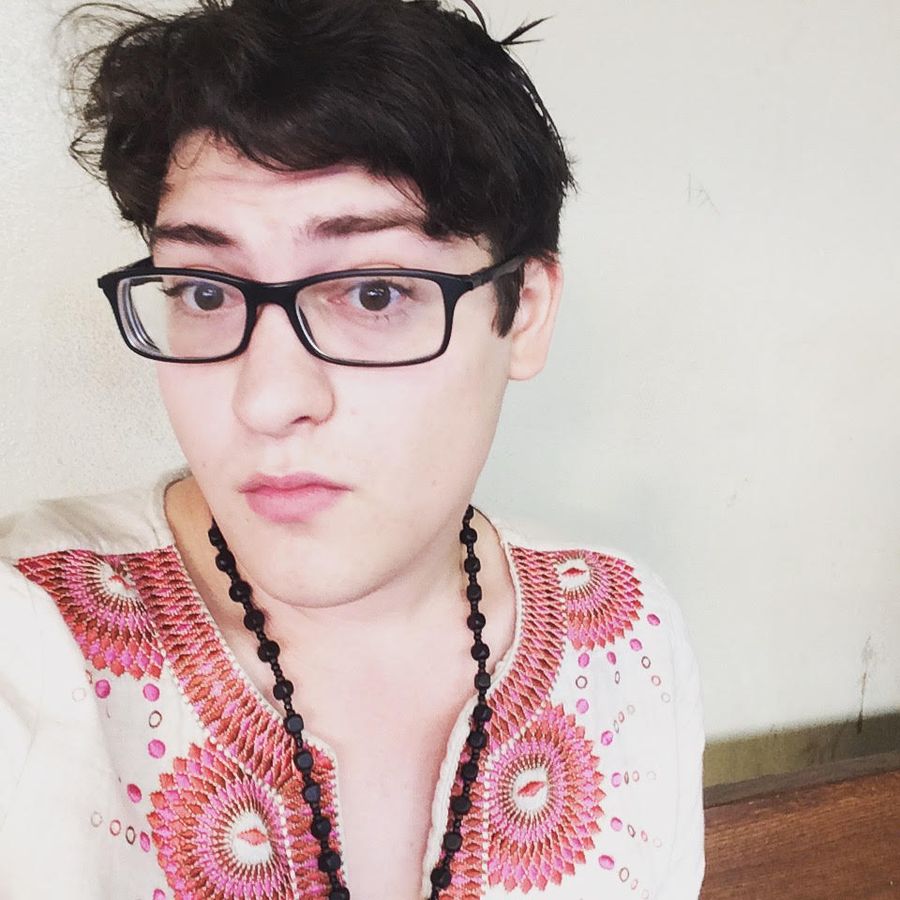
Chase Berggrun is a trans poet. They are the author of R E D, a booklength erasure of Bram Stoker's Dracula, forthcoming from Birds, LLC in 2017, and the chapbook Discontent and Its Civilizations: Poems of Erasure, published by jubilat in 2012. Their work has appeared or is forthcoming in the PEN Poetry Series, Pinwheel, Sixth Finch, Diagram, The Offing, Prelude, Apogee, Beloit Poetry Journal, and elsewhere. They received their MFA from New York University.
Grand Dessein
I let this project and process transform and progress the more I sat with it. I took the Rolodex cards with me to other cities and states and considered what I might do with them. For a while I doodled on them and then wrote phrases that stood out to me from reading I was doing.
At this time I started reading the diaries of Paul Klee. I became immersed in his writing and his work. My friend joked that I was having a romance with Paul Klee, and this isn't far off the mark. I started not just by writing things on the cards, but by creating cards out of other objects and doing away with the paper ones: large photographs that a friend had found in a garbage pile, textile and wallpaper samples. Somewhere in here, I began to think about printing or stamping on the cards and so I purchased alphanumeric stamps and ink pads. Each stamped word is assembled by hand, then disassembled, and assembled into the next word.
Stamping did not seem "permanent" enough--what if the cards got wet? So I decided to "waterproof" them by creating encaustics and dipped each stamped card in dish of melted beeswax, which I melted using a double boiler method. I also began scanning images of his diaries and printing them, and traced the outline of the Rolodex cards onto the images. These were then cut out and shaped using a very sharp knife and glued onto the actual Rolodex card and then coated in the melted wax.
Once I had all the cards (some 250+), I began assembling them into the Rolodex. While Klee's comments about art and the world are fascinating, the placement of his drawings and images in the diaries seem almost arbitrary. Thus I tried to find a connection between his diary musings and selected drawings, and arranged them that way while interspersed with the photographs (onto which the Rolodex card outline was traced and then cut out and shaped with a knife, to replace the Rolodex card altogether). The photograph cards are interjections between the sentences and Klee's images, but comment or reflect both.
Why Klee? Almost pure chance, but I've had a strong connection to Klee's work for the better part of a decade. Entering the mind of an artist is a fascinating thing, and Klee's is not the most hospitable. He was a jerk in his early years. But he was so immersed in the world, in art and music, that his intellect was incredibly active. Even though he almost talks more about music than art (he was a professional violinist) his thoughts change and develop (thankfully) over time. I gained greater familiarity and intimacy with his work and theories and am now working on a much larger written work inspired by Klee.
"Grand Dessein" is French for "Grand Design," and the nature of the Rolodex itself allows a reader/viewer to enter and exit the object's design at any point, as the meditations are always ongoing in the Rolodex's cyclical fashion. It provides a very tactile and sensory experience. The cards "click" against each other like cards in the spokes of a bike wheel, and the beeswax emits a pleasing aroma of honey.
About the artist
Lillian-Yvonne Bertram

Lillian-Yvonne Bertram is an Associate Professor of English, Africana Studies, and Art & Design at Northeastern University. Previously they directed the MFA in Creative Writing at UMASS Boston. They have previously taught at St. Lawrence University, Ithaca College, and Williams College. They also direct the Chautauqua Institution Writers’ Festival.
They are the author of the forthcoming poetry collection Negative Money (Soft Skull, 2023), and the poetry collections Travesty Generator (Noemi Press, 2019), winner of the 2018 Noemi Press Poetry Prize and finalist for the National Poetry Series. Travesty Generator received the 2020 Poetry Society of America Anna Rabinowitz Prize for interdisciplinary and venturesome work. They are also the author of Personal Science (Tupelo Press, 2017); a slice from the cake made of air (Red Hen Press 2016); and But a Storm is Blowing From Paradise (Red Hen Press, 2012), chosen by Claudia Rankine as the winner of the 2010 Benjamin Saltman Award. Bertram’s other publications include the chapbook cutthroat glamours (Phantom Books, 2012), winner of the Phantom Books chapbook award; the artist book Grand Dessein (commissioned by Container Press), a mixed media artifact that meditates on the work and writing of the artist Paul Klee and was recently acquired by the Special Collections library at St. Lawrence University; and Tierra Fisurada, a Spanish poetry chapbook published in Argentina (Editoriales del Duende, 2002). They collaborated with the artist Laylah Ali for the exhibition booklet of her 2017 art show The Acephalous Series.
Bertram has published poetry, prose, and essays in numerous journals, their honors include a 2017 Harvard University Woodberry Poetry Room Creative Grant, a 2014 National Endowment for the Arts Poetry Fellowship, finalist nomination for the 2013 Hurston/Wright Legacy Award, a Vermont Studio Center Fellowship, and fellowships to the Bread Loaf Writers Conference, Cave Canem, and others.
Bertram holds a PhD in Literature & Creative Writing from the creative writing program at the University of Utah, among degrees from Carnegie Mellon University and the University of Illinois at Urbana-Champaign.
MINIATURE PERIMETER
MINIATURE PERIMETER maps Kadena Air Base’s perimeter fence onto the Rolodex’s spinnable, cylindrical form. Each spread of Rolodex cards is a matched set of images: the view into and out from the fence at the same point along the perimeter. MINIATURE PERIMETER invites you to circumnavigate the base, whose entirety is contained within this Rolodex, as I did in December of 2016.
The handwritten text accompanying the images comes from the official document governing the legal status of the base, informally called the Status of Forces Agreement (SOFA), whose full name is the “Agreement under Article VI of the Treaty of Mutual Cooperation and Security between Japan and the United States of America, Regarding Facilities and Areas and the Status of United States Armed Forces in Japan.” I hope that readers will find interesting discontiguities and resonances between the images and the reproduced text—for example, the photographs of the vegetable gardens and chicken coops inside the fence juxtaposed against the portion of the SOFA’s text allowing Japan to permit Japanese nationals to make interim use of such facilities and areas.
What the SOFA and the perimeter fence have in common is their power over the imagination as well as over concrete actions in the real world. They are accepted as impervious, eternal fixtures of the legal and literal landscape of Okinawa—at least until protests against American criminal activity prompt amendments. The first SOFA amendment came as a result of activism in 1995 when three servicemen raped a twelve-year-old girl. The second resulted from protests in the wake of last year’s murder of an Okinawan woman by a former Marine civilian contractor. Also last year, base authorities painted orange boundary stripes across the base’s five entrance driveways, extending the fence’s literal barrier symbolically across unfenced space, in order to prevent protesters from approaching the gates. My hope is that this anxiety about the power of the fence as boundary and the SOFA as binding document increases, and that further revisions to the sovereignty agreements may become increasingly possible. Nothing about the base is natural. May it seem ever less so.
I wanted to keep in mind that the Rolodex's purpose is to organize information and make it easily accessible. I was especially interested in its cylindrical shape, how it encourages the sense that there's no real beginning or endpoint. The fact that I'd just walked around the air base, a perimeter with its own organizing logic and also without real beginning or end, was serendipitous. I had been looking for a way to use the photographs I'd taken, and it was really exciting to think about containing that walk--the hours it took, the several miles, the several thousand steps--in a 6x6x6 space. I took a lot of pleasure, too, in measuring out the words to fit the number of cards I used. Handwriting the text echoed the physicality of the walk itself, the time it took, the slow pace.
About the artist
Collier Nogues
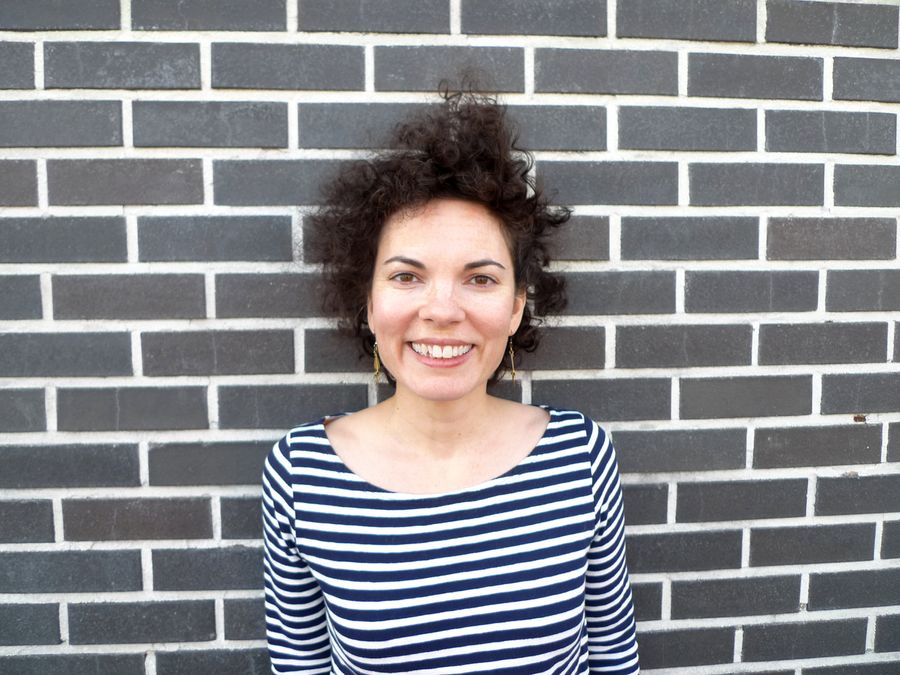
Collier Nogues’ poetry collections are The Ground I Stand On Is Not My Ground (Drunken Boat, 2015) and On the Other Side, Blue (Four Way, 2011). Her work has been supported by fellowships and grants from the MacDowell Colony, the Ucross Foundation, Vermont Studio Center, and Lingnan University. She teaches creative writing in the Chinese University of Hong Kong’s MA Program in Literary Studies, and is a PhD Fellow at the University of Hong Kong, where she studies contemporary poetry’s response to US militarization. She also co-edits poetry for Juked and curates Hong Kong’s English-medium poetry craft talk series.
Notes to Self
My starting point was thinking about how the Rolodex is a personal, paper-based memory retrieval system, using an alphabetical organizational system – and how I could do something different with it. Instead of focusing on names of people or contact information for businesses and other contacts, etc., I thought dealing with memory in a more general and subjective sense. I also wanted to divide the 500 cards into a slightly more manageable group of five sets of one hundred, each to be thematically distinct, yet with some inevitable overlap.
(This was after rejecting my initial plan to write a 500-word text on the cards, which I thought might be too challenging to read. I did, however, do this with one 100-word text in the project). The five parts of the Notes to Self project are:
Concentration (Black)
A 100-word text, read sequentially on the Rolodex cards, about playing the memory game Concentration.
100 Things That Make Me Happy, 2017 (Red)
This is a reprise of a project I originally wrote by hand then printed on post-it notes, as reminders of the things (often abstract concepts in fact, more than objects) that make me happy. I’ve updated the list for Multitudes.
On Memory (Green)
Reflections on the nature of memory, involving personal and literary references as well as word associations.
Notes to Self (Blue)
A selection of notes to myself, ranging from the sublime to the mundane. They include short grocery lists as well as aspirational reminders to read more of certain authors.
Words to Remember (Orange)
A list of words I’ve complied over time, which I plan to use in an upcoming art project. I often keep note of vocabulary words in disparate places, but have brought them together for Multitudes.
About the artist
Barbara Balfour

Barbara Balfour is a Toronto-based artist whose practice has long involved the relationship between the textual and the visual. Her research into text-based art practices and print’s relationship to multiplicity informs her production in artists’ books and multiples, as well as print installation. Her artist’s book The Inkiest Black, in the collection of the MoMA Library, is a response to David Foster Wallace’s Infinite Jest, with a particular focus on his wide-ranging vocabulary and eloquent, idiosyncratic descriptions of colors. Balfour’s other activities include artist residencies (Leighton Colony, Banff Centre, Alberta, Canada; Red Gate Residency, Beijing, China), self-directed periods of research (Marfa, Texas – Judd Foundation; Amherst, Massachusetts – research related to Emily Dickinson), curatorial projects, and critical writing.
Rotary 23
I was inspired first by View-Masters - those wheel-y viewers depicting scenes from movies in seeming three dimensions. It seemed to me that cutout poems, spread out across multiple frames, might make for an interesting layered effect, adding physical depth and providing multiple ways to read the poem. I wanted to work in the constraints of a Rolodex - the sleeves are traditional Rolodex sleeves, and cards are manipulated by a person. Each cut and mark is by hand, and there are still artifacts from how the work is put together in the frames. I also liked the fact that a Rolodex comes in an order, but cards are sometimes replaced mistakenly, which made me wonder what new meaning might emerge if the reader re-arranged the cards. The idea of a reader's ability to alter the text was very appealing to me.
About the artist
james (w) moore

james (w) moore is a poet and playwright. He is the author of I Am the Maker of all sweetened possum, a visually eclectic collection of found poetry published by Silver Birch Press. His plays have been performed in Portland (OR), Seattle (WA), and Burlington (VT), and range from an adaptation of Robin Hood to a surreal comedy about race and conformity (and cars destroyed by shopping carts).
Poems of his have been found (purposefully) on Vermont Edition, as well as in the Houston Chronicle, Silver Birch Press, and Found Poetry Review. He graduated from Lewis & Clark College with a B.A. in theatre, with honors in playwriting, and minors in music and English. James lives in Burlington , Vermont, where he is writing new poetry and plays, and teaching middle school language arts.
On Suspicion That Windmills Are Books
To create On Suspicion that Windmills are Books, a book-object in the form of a Rolodex, I used a Trodat Professional 5253 Heavy Duty Self-Inking Do-It-Yourself Custom Stamp to make unique impressions on the Rolodex cards. The Trodat stamp set came with three and four millimeter rubber type that—with the help of a pair of plastic tweezers—could be set into the stamp’s text plate, which measures about two inches wide and one inch tall. With each stamped impression, I could print a brief poetic fragment—up to five or six lines with about two or three words per line. It seemed the perfect writing implement for the miniature landscape of the 4 x 2 ¼ in. Rolodex cards. At the same time, it seemed the worst implement possible: a self-inking stamp, the Trodat 5253 is, of course, best suited to imprint many copies of the same text. For example, one of the sample texts displayed on the stamp’s box reads as follows:
DELL’S HOT DOGS
7 YORKSHIRE AVE.
ANYTOWN, USA 12345
TEL. 1-800-555-5309
FAX 1-986-555-5372
OPEN 24 HOURS
Setting the type piece by rubber piece, from right to left, was painstaking enough but to remove the type and return it to its 4 x 1 ½ in. plastic tray only to start the process again was a truly perverse exercise, a deliberate use of a technology against the grain.
Then again, I wanted to combine composing, designing, typesetting, and printing into one single ensemble of activities, a glacially slow process that could allow for a maximum amount of meditative deliberation. Like illuminating a medieval manuscript. Like trimming a bonsai tree. In other words, if I was going to print a text, I would need to be fully committed to it given the amount of time and labor required to typeset it. I wanted a poetics of care antithetical to President Trump’s ill-advised “cofveve.”
I got the idea to use the Trodat stamp from the Chilean fiction writer Matías Celedón, whose novella La filial (Alquimia Ediciones, 2012) takes the form of a stamped ledger (Melville House released an English version in 2016). Whenever I encounter a rigorous technique—in any medium—I often think, “How could that be applied to poetry?”
About the artist
Michael Leong

Michael Leong's most recent books of poetry are Cutting Time with a Knife (Black Square Editions, 2012) and Words on Edge (Black Square Editions, forthcoming). An electronic book, Who Unfolded My Origami Brain?, a digital presentation based on some of the master prints of On Suspicion that Windmills are Books is forthcoming from Fence Digital. His critical writing has appeared or is forthcoming in journals such as A Contracorriente: A Journal on Social History and Literature in Latin America, Contemporary Literature, Modern Language Studies, and Journal of Modern Literature. With Ignacio Infante, he is translating the Chilean avant-gardist Vicente Huidobro; portions of this translation project have been published in Asymptote and the Boston Review. A former NEA Literature Translation Fellow, he is Assistant Professor of English at the University at Albany, SUNY, where he teaches creative writing and literary study.
I didn’t know if this tenderness was mine to give.
I met Matt Morris at the School of the Art Institute of Chicago after a Claudia Rankine lecture. I sat with my friend, confidant, and collaborator Angela Davis Fegan on the balcony. Rankine and Dean of Graduate Studies Arnold Kemp only took questions from members of the audience on the lower floor. Rankine dodged question after question from the crowd about the violence she showed in her videos. Angela and I weren’t surprised. A majority of the people given the microphone were young black women who admired Rankine’s work but couldn’t integrate the violence depicted in the videos with the artist-activist they had come to idealize.
I stood up and yelled a set of questions from the balcony at some point. (I’ve learned since that artist Q&As are public relations events, not sites for inquiry.) I wanted to know why Claudia felt so comfortable citing conceptual artists and psychoanalysis while displaying black death in a manner no different than online porn compilations. If I remember correctly, she said that my demand already answered the question it sought. (Sure, my questions tend to be condemnations.) Regardless, Matt found me in the crowd and gave me his card. We met at the Chicago Athletic Club a few months later and decided to collaborate on a perfume project. We may have also expressed interest in seeing each other in a more romantic capacity.
As spring progressed, it became clear that I would be moving to Los Angeles. Matt and I had grown very close since our first interaction. I don’t think either of us was prepared for separation. And then I received a rolodex in the mail.
I wanted to explore the rolodex’s function as an index or archive. I consider myself a critic more than an artist, so I began to search for ways that I could load the object with content that didn’t immediately satisfy the aesthetic demands of the viewer. I wanted the object’s use to correspond to its sentimental value. I began to photograph Matt’s wonderfully curated and expansive library. The rolodex documents a last-ditch effort to contain every book in Matt’s library on a card so I could generate a reading list. However, as opposed to organizing the cards alphabetically, I decided to save them in the order Matt and I opened their covers or photographed them on the shelf. It became a means to relive the experience of Matt and I, often sleepily or late at night, opening book after book and making small talk because we just needed a professional excuse to spend time together.
The rolodex itself is barely altered. I’ve inscribed titles and author (in some cases the publisher) on the front of the card and extraneous information on the back. I settled for minimal information as opposed to formatted citations because I wanted the experience to be more about memory and handwritten text than mediation. I also wanted to the object to barely succeed, to remain a gesture, more than anything else.
About the artist
Evan Kleekamp

Evan Kleekamp is a researcher and writer living in Chicago, Illinois. Excerpts from his in-progress manuscript, Three Movements, are forthcoming in Fence and Nightboat Book’s Responses, New Writings, Flesh anthology edited by Ronaldo V. Wilson, Bhanu Kapil, and Mg Roberts.
The Book of Un with Undex
For the longest while I thought I would be doing something around the idea of an Index. I am a lawyer by training, and many years ago I prepared indices for a legal publishing house, so the idea of the Rolodex brought back the process of systems that aid the reader or searcher in finding information, which is what the index does. I was intrigued by the idea of the tension between the circle and the straight line, which when bent becomes the circle. The Rolodex is in fact a wheel which you turn, but the alphabet is sequential and is akin to a straight line with letters laid out one next to the other.
I researched codes because again the idea of a system that allows you to enter an area that is closed to you seemed relevant. I was also intrigued by the idea of the Index put out by the Vatican which was in fact a sort of reverse index, in that it contained a list of books that "good" Catholics were prohibited from reading. The Index was, in fact, a system that fundamentally subverted the common understanding of what an index is intended to do -- give you access to further information.
The Rolodex sat on my kitchen table for the duration of time I was thinking about what I would do with it. I then started taking out the cards and looking at them and one day decided I would burn the edges of some. The others sat on a shallow pan on top of a toaster oven while I did this. I then had the idea of baking them but thought to use brewed black tea to soak them in as they baked -- not wanting them to catch fire. The results were startling and beautiful. They also retained the smell of the tea. From that it was easy to move to using green tea, beet juice and coffee.
I still had no idea how to realize my ideas about the Undex. Then one morning I awoke and the entire story about the Book of Un was there. I have for the longest while been interested in the power of the prefix un. Two letters that somehow are powerful enough to reverse certain acts or states, but that didn't work for others. The prefix un can be seen to be a kind of spell. Perhaps, also, the idea of the Index of the Catholic church that was really an Undex as it tried to undo the existence of certain books and writings was also at work. The culmination was The Book of Un with Undex, the latter being those words that defy being "unned."
About the artist
M. NourbeSe Philip
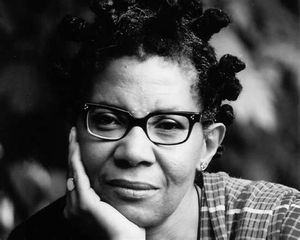
M. NourbeSe Philip was born in Tobago. She earned a BSc from the University of the West Indies and an MA and LLB from the University of Western Ontario. Philip was a practicing lawyer for seven years before turning full-time to writing. She is the author of works of poetry, fiction, and nonfiction. Her collections of poetry include Thorns (1980); Salmon Courage (1983); She Tries Her Tongue (1989); Her Silence Softly Breaks (1988), which won a Casa de las Américas Prize for Literature; and Zong! (2008), a polyvocal, book-length poem concerning slavery and the legal system.
In addition to poetry, Philip has published two novels: the young adult novel Harriet’s Daughter (1988), a runner-up for both a Canadian Library Association Prize for children’s literature and a Max and Greta Abel Award for Multicultural Literature, and Looking for Livingstone: An Odyssey of Silence (1991). Philip’s short story “Stop Frame” received a Lawrence Foundation Award in 1994. Her play Coups and Calypsos (1999) has been produced in both Toronto and London.
Philip’s essay collections include Frontiers: Essays and Writings on Racism and Culture (1992), Showing Grit: Showboating North of the 44th Parallel (1993), CARIBANA: African roots and continuities—Race, Space and the Poetics of Moving (1996), and Genealogy of Resistance and Other Essays (1997).
Philip’s numerous honors and awards include fellowships from the Guggenheim Foundation, Rockefeller Foundation, and MacDowell Colony. She is the recipient of awards from the Canada Council for the Arts, Ontario Arts Council, and Toronto Arts Council. In 2001, she was recognized by the Elizabeth Fry Society with its Rebels for a Cause Award, and the YWCA awarded her its Women of Distinction in the Arts Award. Philip has received a Chalmers Fellowship in Poetry and has been writer-in-residence at Toronto Women’s Bookstore and McMaster University. In 2012, she received a NALIS Lifetime Literary Award.

